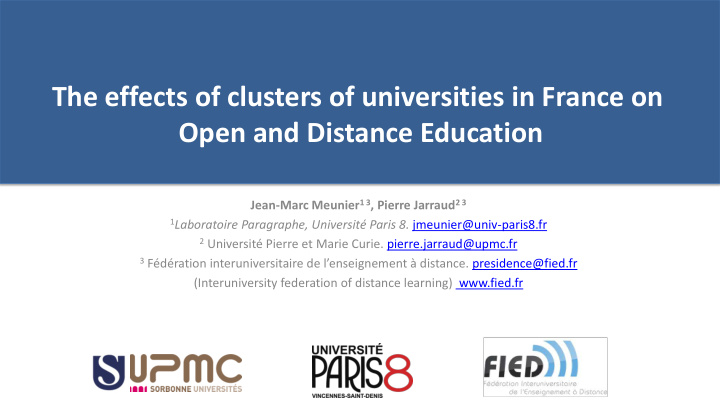



The effects of clusters of universities in France on Open and Distance Education Jean-Marc Meunier 1 3 , Pierre Jarraud 2 3 1 Laboratoire Paragraphe, Université Paris 8. jmeunier@univ-paris8.fr 2 Université Pierre et Marie Curie. pierre.jarraud@upmc.fr 3 Fédération interuniversitaire de l’enseignement à distance. presidence@fied.fr (Interuniversity federation of distance learning) www.fied.fr
Clusters of universities in France Research and higher education clusters (PRES) Community of universities and establishments (COMUE) * Fusion * Federation * Association
Aix Marseille Université (AMU) • Merger completed in 2012 after a long preparation and finalization process. • Merger of competing universities (teaching the same specialities) • The merger was an opportunity to modernize governance and renew pedagogy (pedagogy by program) • A long tradition of distance learning structured around two centres: Aix (humanities) and Marseille (science) • A teacher support and training centre (CIPE) • A desire to increase porosity between face to face and distance learning through a program approach and similar diploma framework.
Université de Lille Nord Europe (ULNE) • The merger of the three universities of Lille is planned for 2018 • Complementary universities with a clear disciplinary division. • A tradition of using digital technology in education and technical support services (SEMM) and pedagogical support services (SUP) • But no dedicated distance learning service, despite many years of experience. • A desire to develop an approach based on longlife learning and professional integration. • A reorganisation of distance learning with a centralisation of support services and the creation of a pedagogical innovation centre (LILLIAD)
Common points & differences Common points Differences • Dialectic between centralization and AMU ULNE autonomy • 2 ODL services ODL service in future Increased porosity between classroom and distance learning. Support service for Support service for OER • Increasing the logic of management by call OER for projects at national and local level. Innovation center Support service for pedagogy -> – Significant funding (ie PIA= €57 billion) innovation center – Problem of sustainability of project (except IDEX) Program approach Longlife learning approach – Opportunistic strategy risk • A proactive approach to international university development
THANKS FOR YOUR ATTENTION Read the whole CPL 2017 report soon http://www.changingpedagogicallandscapes.eu/ For contatct us jmeunier@univ-paris8.fr pierre.jarraud@upmc.fr presidence@fied.fr www.fied.fr You are welcome for the 30th anniversary of the FIED on December 13th and 14th in Paris See : https://cified2017.sciencesconf.org/
Conclusions The call for projects policy acts as an engine. There are fluctuations in strategies with the creation of clusters. International visibility is a motivation for grouping (size and width of the spectrum) The fusion does not erase the previous policies but makes them evolve towards more integration in particular in Lille. Trends : Sharing of technical and administrative support Blending Face to face / Online / At the distance OER production, decrease in ‘proprietary' courses Strategy towards diploma trainings but cautious on Mooc
STOCK DE DIAPOS AU CAS OÙ
La FIED Fédération interuniversitaire de l’enseignement à distance Créée en 1987 à l’initiative du ministère • 35 universités ou COMUE • Institut national de la transfusion sanguine • Deux universités francophones Laval (ca) et Unidistance (ch) Un site web : fied.fr
Les Missions de la FIED (1) Catalogue des formations à distance universitaires Journées thématiques : ‣ récentes : Représentation à l’international récentes ‣ prisonniers, (EADTU, EDEN, ICDE) ‣ FTLV et EAD Information , formation des membres ‣ A venir : par des journées thématiques ‣ certification, ‣ normes et standards et formations en ligne
Les Missions de la FIED (2) Les groupes de travail : ‣ qualité, Mutualisation des bonnes pratiques : ‣ incarcérés, ‣ sportifs, handicapés, artistes ‣ tutorat, ‣ certification, ‣ dématérialisation, ‣ aspects juridiques de l’EAD, ‣ bibliothèques.
Du téléenseignement à l’enseignement en ligne Une formidable évolution Dans les années 80, un directeur de centre de ‣ 1980, l’EAD : la poste et le téléenseignement est un gestionnaire de téléphone, le minitel formation. ‣ 1990 : le mail Les étudiants des CTU font partie du « public ‣ 2000 : les plateformes empêché ». d’enseignement, les pdf, Des postes fléchés « enseignement à distance » les forums sont ouverts. ‣ 2010 : les vidéos, la classe distante Avec le LMD d’abord, avec les TICE ensuite, tout ‣ 2014 : les outils entre pairs, cela n’a plus de sens. les examens en ligne
Recommend
More recommend